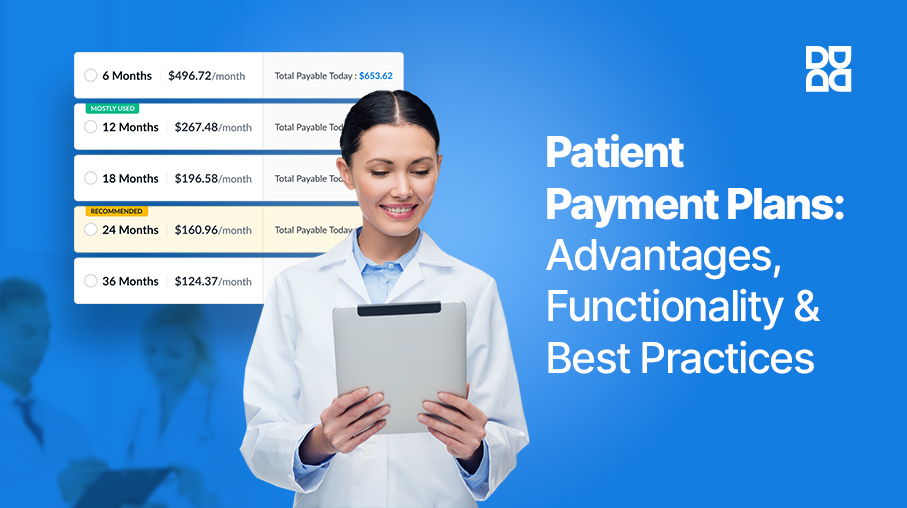
Healthcare debt is a burden for a large share of Americans.
| Yes, approximately four in ten adults report having debt due to medical or dental bills including debt owed to credit cards, collection agencies, family & friends, banks, and other lenders. |
With that said, it's no news that about half of U.S. adults say they have difficulty affording health care costs. However, what's surprising is that even those who are covered by health insurance are not immune to it.
Discover the Power of Flexible Payment Options
Check Out Our Guide to Learn The Benefits Of Offering Them
This affects patients and providers alike, and such has been the case for a long time. Now, it is a well-known fact that adversity breeds innovation. And given the concerning state of healthcare, providers across the board have also adopted an innovative approach to make their services more affordable and accessible. Enter- Patient Payment Plans.
| In this blog, we will discuss: ➡️Patient Payment Plans ➡️Advantages of Using Patient Payment Plans for Providers and Patients ➡️How a Patient Payment Plan Works ➡️Best Practices for Successful Patient Payment Plan Implementation ➡️Denefits, An Inclusive, Comprehensive Patient-Centric Solution |
What Are Patient Payment Plans?
Simply put, patient payment plans refer to a structured agreement offered by healthcare providers to patients, allowing them to pay in manageable monthly installments over a specific period.
This means two things:
1. Patients can avail of healthcare services as and when needed without worrying about paying the cost upfront or in a lump sum.
2. Providers don't have to turn patients away because of lack of insurance or low-paying capacity and suffer losses.
That's just a brief overview, patient payment plans offer great respite to patients in many scenarios and provide just as many opportunities to providers. Let’s discuss them in detail.
Advantages of Patient Payments Plans: For Patients and Providers
Patient payment plans go a long way in making healthcare services accessible, affordable, and beneficial for patients and providers alike. Moreover, these payment plans pose a convenient option to patients who avoid or delay even acute care. And a way for providers to cater to more patients and grow their practice.
| Patients | Providers |
|---|---|
| Cover unexpected medical emergencies or accidents | Ensure a consistent revenue stream |
| Manage ongoing costs of chronic health conditions | Retain patients by making healthcare costs manageable |
| Afford expensive medical procedures and surgeries | Reduce the risk of unpaid bills and lower bad debt expenses |
| Bridge the gap of limited or no health insurance coverage | Receive regular payments and aid cash flow management |
| Access dental, orthodontic, and vision care | Simplify the billing process |
| Handle maternity and obstetric care expenses | Adhere to regulatory guidelines on patient billing |
| Support mental health treatment and therapy | Reduce administrative overhead costs |
| Pay for preventive health screening | Increase customer satisfaction and encourage positive feedback |
Patient Payment Plans: A Step Towards Inclusivity
| Did you know? High healthcare costs disproportionately affect uninsured adults, Black and Hispanic adults, and those with lower incomes. |
Patient payment plans play a pivotal role in promoting inclusivity within the healthcare system. These patient payment options effectively break down medical costs and increase financial accessibility, enabling patients to afford necessary treatments regardless of their insurance coverage, income level, background, or even credit history.
Moreover, such medical payment plans have high approval rates and a fast processing time, making it easy for patients to turn to them in times of need, no matter how unprecedented. Over and above that, patients can customize their payment schedules, given the provider supports it, making it an all the more convenient option.
On the whole, patient payment plans contribute to creating equitable access to medical services by acknowledging and addressing the financial diversity of patients, thereby fostering a more inclusive and patient-centric approach to healthcare.
How Patient Payment Plans Work
Although how a patient payment plan works can vary based on numerous factors including the terms of the facilitator and the provider offering them, there are a few steps that remain. Let’s go over them.
◾Assessment and Agreement
Once a patient opts for a payment plan for medical bills, next comes a patient payment plan agreement. For this, the provider will evaluate the financial status of the individual and propose a suitable payment plan.
◾Terms and Consent
Providers will establish formal terms for the payment plan and obtain explicit consent from the patient before proceeding with any financial arrangements.
◾Payment Execution
Upon agreement, providers will set up a monthly installment schedule for the patient, with the option for auto-pay for added convenience.
◾Flexibility and Communication
Providers will allow for plan adjustments as needed and encourage open communication between the provider and the patient throughout the payment period.
◾Completion and Consequences
The payment plan will continue until the total amount is paid in full. Non-compliance with the agreed-upon terms may have consequences, including potential impacts on the patient's credit.
Best Practices for Successful Patient Payment Plan Implementation
▶️Leverage Automation for Payment Collection
Relying on manual payment processes and follow-ups can frequently lead to disappointment. To substantiate that statement, it's important to note that timely repayments remain a challenge for most healthcare providers. Implementing an automated payment collection system is an effective way of overcoming these challenges. By leveraging automation, providers can reduce administrative overhead, process payments securely, send automated reminders, and handle recurring payments conveniently. This can positively impact providers and enhance the overall experience for patients.
▶️Lead With a Patient-Centric Approach
More often than not, patients are already overwhelmed trying to process things. So, as a provider, your priority should be to make it as easy as possible for the patients to avail yourself of patient payment plans. Simplify the process to the very last step. Keep communication direct and transparent.
Put yourself in your patients' shoes, and offer them as much flexibility and convenience as you can. Further, allow them to customize their payment plans as per their financial situation. For example, allow them to choose the tenure of repayment. So, remember to choose a patient-first payment plan.
▶️Integrate Patient Payment Plans on Your Website
Patients seldom visit practices right off the bat; their first instinct is mostly to search through your website to know what services you offer, or even book an appointment. Integrating the option of patient payment plans seamlessly into your website can prove to be a deciding factor. It'll spare your patients the effort of reaching out to you to ask whether or not you offer patient plans. They'll know from the outset.
Moreover, it'll allow them to explore, review, and select their preferred payment plan without any fuss. Moreover, it can lead to increased patient engagement, inquiries, and conversion rates. So, ensure you can integrate the patient payment plan software you choose into your website.
▶️Integrate Multilingual Support into Your Payment Options
The best way to reach out to your customers is in their language. This is where incorporating multilingual payment plans can be a differentiator for your business. Adopting a multilingual approach can foster inclusivity, making potential customers from diverse linguistic backgrounds feel valued and engaged.
Moreover, offering a customizable medical payment plan in various languages demonstrates a dedication to addressing individual requirements and cultivating enduring relationships. This not only builds trust but also inspires loyalty, ultimately increasing the lifetime value of customers.
Patient payment plans not only alleviate financial burdens but also empower healthcare providers to serve a diverse population, fostering a more equitable healthcare system. However, for achieving this, finding the most effective payment plan program facilitator is just as crucial, one like Denefits,
preferred by patients and providers alike. Let's learn why.
Denefits: An Inclusive, Comprehensive Patient-Centric Solution
| ◾Inclusive Healthcare Plans: Denefits ensures its healthcare payment plans are accessible to low-income individuals, irrespective of credit scores, promoting greater access to necessary care. ◾No Credit Check Policy: With its NO CREDIT CHECK policy, Denefits enables providers to approve most patients, regardless of their credit history. ◾Flexible Payment Options: Patients can customize payment plans, allowing them to pay in manageable monthly installments with flexible tenures. ◾High Approval Rate: Denefits has a 95% approval rate, instilling confidence in patients and enabling providers to serve a diverse customer base. ◾Seamless Website Integration: It facilitates the integration of patient payment plans on provider websites, enhancing the patient experience and accessibility. ◾Multilingual Payment Plans: Denefits' multilingual payment plans cater to a diverse audience, increasing provider reach and enhancing patient satisfaction. |
Conclusion
The pervasive issue of healthcare debt in the United States has spurred innovative solutions, notably patient payment plans. These plans, structured to allow manageable monthly installments, address the financial challenges faced by a significant portion of Americans. They promote inclusivity, breaking down barriers to healthcare access based on income, insurance status, and background.
However, choosing the right patient payment plan solution is just as crucial, there are various best practices to follow. Denefits exemplifies these practices, offering inclusive healthcare plans with no credit checks and flexible payment options.
FAQs for Patient Payment Plans
What Types of Patient Payment Plans Are Available for Healthcare Services?
There are various types of payment plan options patients can choose from. These include payment plans with deferred interest, flexible payment plans with customizable tenures, etc. Contact your provider to know more about the types of patient payment plans they offer.
Are Payment Plans a Bad Financial Decision for Patients?
For most patients, payment plans offer respite in times of need, no matter how unprecedented. However, it's best to understand the terms and conditions, and the pros and cons of opting for healthcare payment plans before deciding on it.
What Sets Denefits Apart in Terms of Payment Plan Options?
Denefits is the choice of many providers and patients when it comes to payment plan options. In a broad sense, its NO CREDIT CHECK policy, flexible payment options, multilingual support, and easy integration set it apart.


